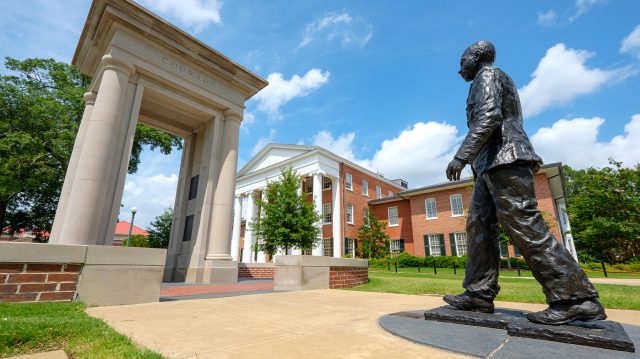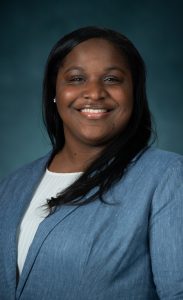
This week’s publication of individual Equity in Action plans for each academic and administrative unit sets measurable goals for which each unit will demonstrate progress toward making the campus a more inclusive and equitable environment for all. Photo by Robert Jordan/Ole Miss Digital Imaging Services
OXFORD, Miss. – After the University of Mississippi rolled out its Pathways to Equity strategic plan in January, individual campus academic and administrative units got to work building their own Equity in Action plans.
With those plans available for everyone to read, the campus community is invited to provide feedback and begin participating at the departmental and individual levels.
The Pathways to Equity strategic plan is a five-year commitment to advance the institutional capacity for equity, cultivate a diverse and equitable community and promote an inclusive campus climate. The publication of the individual Equity in Action plans sets measurable goals for which each unit will demonstrate progress through annual reporting.
“The critical work of diversity, equity and inclusion requires sustained partnerships across all areas of our institution, and I am so pleased every academic and administrative unit has made commitment to proactively engage in this process,” said Shawnboda Mead, vice chancellor for diversity and community engagement.
“The three Pathways to Equity overarching goals, coupled with the Equity in Action plans, provide a road map for building on existing work, promoting inclusivity at all levels for all members of our community and advancing a more equitable campus environment.”
Unit-by-Unit Flexibility
As a part of the Pathways to Equity strategic plan, each campus unit is charged with establishing three or more strategic goals to focus on for the next five years. They must also provide metrics to establish baseline data and conduct annual measurements.
The individual plans are bound by the common goals set forth in the institutional Pathways to Equity strategic plan, but each unit has the autonomy needed to address the unique needs and concerns of its faculty, staff and students as well as utilize the resources uniquely available to each.
“The benefit of this model allows for full ownership and buy-in across all aspects of the institution, allows us to account for strategies that range in their complexity and allows units to individually address specific concerns identified in the 2019 climate study process,” Mead said.
In its Equity in Action plan, the Patterson School of Accountancy committed to targeting the recruitment of faculty, staff and doctoral students from under-represented groups. The school will measure success by the number of search committee members who complete the UM diversity and inclusion search committee training as well as by the diversity of the applicant pools and the ongoing faculty, staff and doctoral student populations.
“The training provided by the university does a great job highlighting many practical actions that would benefit any search,” said Brett Cantrell, associate professor of accountancy and diversity liaison. “We won’t be able to achieve the outcomes we want without taking these steps.
“And recruiting a more diverse faculty and staff can have a flow-through benefit to our students by bringing more diverse perspectives into our classrooms and serving as role models to students.”
The individual plan flexibility also allows units to engage outside, unit-specific resources.
The Department of Intercollegiate Athletics is working with the Southeastern Conference to use the league’s national platform to publicize the department’s diversity statement and social justice initiatives. It also is teaming up with other athletic departments and Mississippi universities to encourage food sustainability and literacy in public schools through a program called Feed the Sip.
Narrowing the Focus
Some departments are already using the unit plan to drive their own initiatives. The Department of Campus Recreation just launched its Inclusive Recreation Committee made up of student employees and professional staff with the goal of providing a safe, welcoming space for people of all backgrounds, abilities and fitness levels.
Shannon Richardson, assistant director of campus recreation and the diversity liaison for the Division of Student Affairs, believes initiatives like these will create a more welcoming environment for all students, faculty and staff because they’ll see their own identities, interests and struggles reflected back to them.
“We’re literally, from the director level down, hoping each unit in student affairs takes a look at areas we need to improve in diversity and equity education,” Richardson said. “Because when students can see a group of people from diverse backgrounds and expertise areas, then hopefully they’ll be able to see themselves in someone in the office and be able to confide in them or seek them out.”
Taking the Next Steps
Members of the Ole Miss community are encouraged to begin participating in these individual action plans.

All members of the Ole Miss community are encouraged to read the individual action plan for their school or other campus unit and begin participating in it to help ensure fairness and equity in all areas of campus life. Photo by Kevin Bain/Ole Miss Digital Imaging Services
Each Equity in Action plan is posted online to encourage feedback, transparency, accountability and buy-in from faculty, staff and students.
“Right now, it would be helpful for people in our community to familiarize themselves with the plans for the units where they’re involved,” said Kirsten Dellinger, associate dean for diversity and inclusion and diversity liaison in the College of Liberal Arts. “It’s a living document, so feedback is important.
“And if you have any interest in becoming involved, contact the person in charge of your plan to see how you can participate.”
Among its focused goals, the College of Liberal Arts is undertaking a cluster hire this fall to attract diverse faculty in cutting-edge fields of specialization. At the same time, the college is beginning a process of reflection on policies and practices at the department level that create diverse, equitable and inclusive spaces for faculty, staff and student work.
As the individual Equity in Action plans are rolled out in units, departments, offices and classrooms across campus, the institutional plan will continue to be honed. Formal progress reporting will begin in the spring semester.
“The success of Pathways to Equity and fulfillment of the goals outlined in the various Equity in Action plans requires an engaged campus community where we intentionally commit to building a culture of inclusion,” Mead said. “There is space for all students, faculty, staff and administrators to join in the advancement of this transformative work.”
